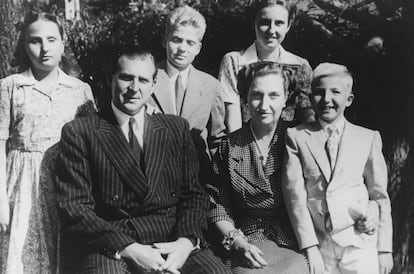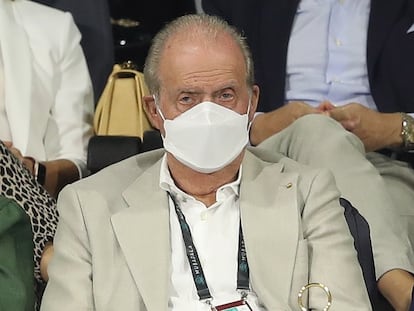How did the former king of Spain kill his brother? A documentary explores the mysterious death of Alfonso de Borbón
Víctor Manuel de Saboya — son of the last king of Italy and childhood friend of Juan Carlos I, the emeritus King of Spain — reveals how he witnessed the accidental homicide of the young duke. ‘He didn’t shoot him directly, but through the closet. I was there. It was 100% an accident,’ the Italian prince says, in a new Netflix docuseries

On March 29, 1956, the Spanish royal family — then in exile — attended a morning mass on Holy Thursday, receiving Communion in the Church of San Antonio, in Estoril, Portugal. After a light lunch, the Count of Barcelona and Juan Carlos I (father to the reigning monarch Felipe VI) accompanied the young Infante [Prince] Alfonso to a golf competition. Despite the bad weather, the 14-year-old — his father’s favorite son — won the semi-final. The Bourbons then returned to their home, the Villa Giralda.
At six in the evening, they attended another mass and came back to the house. A couple of hours later, at half past eight at night, the family doctor, Dr. Joaquín Abreu Loureiro, arrived in a hurry to treat Alfonso. Loureiro would end up certifying that the child died from a gunshot wound to the head. Apparently, Alfonso and his 18-year-old brother, Juan, had been practicing their marksmanship with a small .22-caliber revolver, in the game room on the first floor of the villa. The gun went off. To this day, nobody knows exactly what happened.
“The most absolute silence will surround the details of that fateful event: it’s a mystery, it can only be the subject of hypotheses,” writes Laurence Debray, the authorized biographer of Juan Carlos I, the emeritus king, in his 2014 work, which is the most current biography of the king.
There are up to five different versions of what happened that night. British historian Paul Preston has collected them in his book, Juan Carlos, A People’s King (2003). On Friday, March 30, 1956, the dictator Francisco Franco ordered the Spanish embassy in Lisbon to issue the following statement: “While His Highness the Infante Alfonso was cleaning a revolver [on the night of March 29] with his brother, a shot was fired that hit his forehead and killed him. The accident occurred at 8:30 p.m., after the Infante returned from the religious service on Holy Thursday, during which he had received Holy Communion.” However, the Italian press published a very different version, stating that Juan Carlos I was holding the gun and that his finger was on the trigger when the fatal shot was fired.
In her autobiography, the Countess of Barcelona neither denies nor confirms that Juan was holding the pistol, but she does contradict the official account that was released by Franco’s regime. She apparently revealed to her dressmaker, Josefina Carolo, that her eldest son jokingly aimed the revolver at his younger brother and, without realizing that the gun was loaded, pulled the trigger.
Juan Carlos I told a similar version of this to Bernardo Arnoso, a Portuguese friend. However, he added a detail: according to him, the bullet had bounced off a wall and hit his little brother’s face. And the Infanta [Princess] Pilar — sister of the monarch — apparently told another story to the Greek writer Helena Matheopoulos: that Alfonso had left the room to find something to eat for Juan Carlos and himself. Upon returning with his hands full, he pushed the door open with his shoulder. The door hit his brother’s arm. Juan Carlos involuntarily pulled the trigger, just as Alfonso’s head appeared through the door.
There are many variations of the same story, but all testimonies agree on something: that the Count of Barcelona ran up to the playroom where Alfonso was in a pool of his own blood, and that he tried to revive his son. The child died in his arms. His father then covered the body with a Spanish flag and, according to Antonio Eraso, who was a friend of Alfonso’s, turned to Juan Carlos and said: “Swear to me it wasn’t on purpose.”
Recently, a more scandalous version has circulated, passed around by another member of European royalty. “I was there. We were [also] in exile, and we used to shoot jars and bottles on the beach in Cascais. Juanito shot his brother and killed him,” recalls Prince Victor Emmanuel of Savoy, son of the last king of Italy, in the new Netflix documentary series, The King Who Never Was. “He didn’t shoot him directly but through the closet,” he clarifies. “I was there. It was 100% an accident. I hid my gun, otherwise, they would have said it was my fault.”
In 1978, the Italian was involved in a similar episode. He was charged with involuntary manslaughter and, more than a decade later, acquitted. The prince, a childhood friend of Juan Carlos I, made part of his fortune by acting as an intermediary between Italian weapons companies and the last Shah of Iran. In 2004, he ended up punching Amadeo of Aosta — another successor to the dormant throne of Italy — at the wedding of Felipe VI (the current King of Spain, son of Juan Carlos I) and Queen Letizia. In 2006, he admitted to collecting and paying bribes to obtain gaming licenses for Italian-owned casinos in Switzerland, although he was later acquitted.
The absence of a judicial investigation into the death of Alfonso de Borbón has generated all kinds of speculation for nearly seven decades. The recent statements by Víctor Emmanuel of Savoy have only revived interest in the case. It’s true that no autopsy was ever performed on the prince’s body, nor did the police clarify the circumstances of his death. The boy was buried in the Cascais cemetery on March 31, 1956. After the ceremony, his father picked up the pistol that killed his son and threw it into the ocean.
There were conflicting rumors about the origin of the weapon. According to some, it had been a gift from General Francisco Franco to Alfonso’s father, although that would be unlikely because, as Paul Preston recounts in his book, the Count of Barcelona hated the dictator, referring to him as “the dwarf” or “the toad.” According to others, the pistol had been given to Juan Carlos I at the Zaragoza Military Academy.

The events of March 29 had dire consequences for the Bourbons. Less than 48 hours after the incident, the Count of Barcelona ordered his eldest son to return to Spain immediately. Juan Carlos I became a solitary and reclusive man, tormented by the death of his younger brother. It didn’t help that the dictator Franco allowed the Ministry of Education to approve the publication and use of a high school textbook entitled Catholic Morality, which used the incident to study the limits of personal guilt. The Countess of Barcelona fell into a depression following the death of her son — she had to be admitted to a clinic. Her husband was also weakened by his great rival, Franco. The dictator used the family tragedy to undermine their claim to the throne. When the Count of Barcelona and Franco met in 1960, the latter justified keeping him away from Spain by saying that the Bourbon family was “disgraced.”
In the end, Franco took advantage of Alfonso’s death to put an end to the Count of Barcelona’s claim to the throne. Juan Carlos I was, from that moment on, the only possible candidate to succeed the dictator and restore the monarchy in Spain. As author Rafael Borràs explains, the prince’s death “deprived the Count of Barcelona ― from the point of view of dynastic legitimacy — of a hypothetical substitute in the event that [Juan Carlos I] agreed to be General Franco’s successor, against his father’s will.” As historian Paul Preston points out, if Alfonso had lived, his mere existence would have conditioned Juan Carlos’s subsequent behavior in the fight between his father and Franco.
Felipe VI’s father has never wanted to speak publicly about this episode of his life. “To survive, [he’s used] a classic psychological defense mechanism: the past already belongs to his previous life. The painful subject is thus avoided and hidden,” French psychiatrist Sylvie Angel explained to Laurence Debray, biographer of the monarch, in her book Juan Carlos d’Espagne [Juan Carlos of Spain], the most up-to-date biography of the king published in 2014. “Secrecy, however, can become an even heavier burden,” Angel added.
In a podcast recorded a few months ago, Corinna Larsen — an ex-lover of Juan Carlos I — spoke about how the 85-year-old feels when he remembers the death of his brother. “I think, deep down in his soul and in his head, he feels a lot of guilt. He has nightmares about it.”
“He told me that his younger brother was the really bright one, the handsome one, the best golfer, his parents’ favorite son. Juan Carlos is dyslexic and, despite being left-handed, they forced him to write with his right hand. He was forced to obey. He felt that his younger brother was really the light that shone in the family,” Larsen explained. Almost 70 years later, the ghost of Alfonso continues to haunt Juan Carlos I.
Sign up for our weekly newsletter to get more English-language news coverage from EL PAÍS USA Edition
Tu suscripción se está usando en otro dispositivo
¿Quieres añadir otro usuario a tu suscripción?
Si continúas leyendo en este dispositivo, no se podrá leer en el otro.
FlechaTu suscripción se está usando en otro dispositivo y solo puedes acceder a EL PAÍS desde un dispositivo a la vez.
Si quieres compartir tu cuenta, cambia tu suscripción a la modalidad Premium, así podrás añadir otro usuario. Cada uno accederá con su propia cuenta de email, lo que os permitirá personalizar vuestra experiencia en EL PAÍS.
¿Tienes una suscripción de empresa? Accede aquí para contratar más cuentas.
En el caso de no saber quién está usando tu cuenta, te recomendamos cambiar tu contraseña aquí.
Si decides continuar compartiendo tu cuenta, este mensaje se mostrará en tu dispositivo y en el de la otra persona que está usando tu cuenta de forma indefinida, afectando a tu experiencia de lectura. Puedes consultar aquí los términos y condiciones de la suscripción digital.
More information
Archived In
Últimas noticias
Most viewed
- Sinaloa Cartel war is taking its toll on Los Chapitos
- Oona Chaplin: ‘I told James Cameron that I was living in a treehouse and starting a permaculture project with a friend’
- Reinhard Genzel, Nobel laureate in physics: ‘One-minute videos will never give you the truth’
- Why the price of coffee has skyrocketed: from Brazilian plantations to specialty coffee houses
- Silver prices are going crazy: This is what’s fueling the rally











































